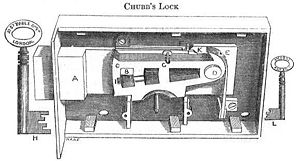Lever
Lever
| This article may require cleanup to meet Lockwiki's quality standards. Please improve this article if you can. |
A lever (or lever tumbler) is a lock design that uses flat pieces of metal (also known as levers) and a bolt as locking components. In most designs, the position of the levers prevents the bolt from retracting. When positioned properly, a gate in the lever allows the bolt to retract. Lever locks are historically one of the most popular lock designs, but use has dwindled as less expensive pin-tumbler locks have gained popularity. Lever locks are popular in Europe (specifically the UK) as residential and commercial door locks and on safes. Safe-deposit boxes in banks around the world use lever designs heavily.
History
One of the early lever lock designs was the Banbury lock created in the late 1700s. This design did not use fences and gates, but rather a simple hinged lever that the key had to lift out of the way in order for the bolt to retract. Security was provided by traditional keyway warding.
Barron lock
In 1778, Robert Barron patented the first lever lock that used a fence and gates. The levers utilized a technique called double action in order to provide increased security. This technique requires each lever be lifted to a precise height at which the fence can pass through the gate. Overlifting a lever causes it to block the fence; older locks' levers could just be lifted to any height as long as they cleared the obstacles. The double-acting lever principle is still in use to this day, and was also eventually applied to pin-tumbler locks by Linus Yale, Jr.
Chubb lock

In 1827, Charles and Jeremiah Chubb patented a lock design based on Barron's work. Their version reversed the placement of the fence and gates, attaching the fence to the bolt and the gates to the levers. This design still in use today in many locks. They also added a device called the detector, an extra lever that triggered by overlifting of the main levers. When triggered, the Detector would lock the bolt until it was reset with a special key. Chubb added serrations on the gate levers which prematurely bound components if tension was applied when the component was in the incorrect position. This design was also eventually included in security pins by many other lock designs. In 1883, Chubb patented a rotating barrel that closed off the keyway when the key was turned. This addition helped to prevent decoding.
Tucker and Reeves
In 1851, a new design surfaced with a bolt that was not rigidly fixed but could shift on one end. Patented by Tucker and Reeves, this design aimed to thwart picking attempts involving pressure on the bolt. The shifting bolt made it harder to feel the gates inside the lock as it shifted. In 1853, the design was refined to include a rotating barrel that prevented movement of the bolt until a key was inserted.
Parsons lock
In 1832, the Parsons lock was created. This design had seven symmetrical levers that pivoted around their midpoint (traditional levers were hinged at one endpoint). The key lifted the levers at one end and the bolt had notches at both ends. Overlifting any lever would cause it to engage the notch in the bolt and lock it at that end even if the other end had cleared the bolt.
Principles of Operation
Add to me!
Vulnerabilities
Lever locks are vulnerable to a wide variety of attacks depending on their design. Tools to pick and decode lever locks are not as widely available as their pin-tumbler counterparts, but are equally prevelant and effective.
Notes
- Lever locks are not subject to key bumping or pick gun attacks.
References